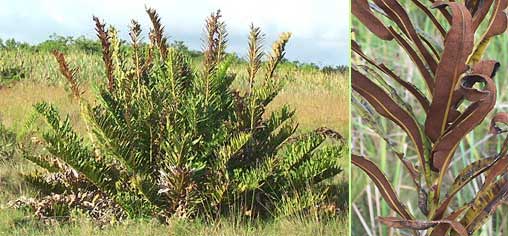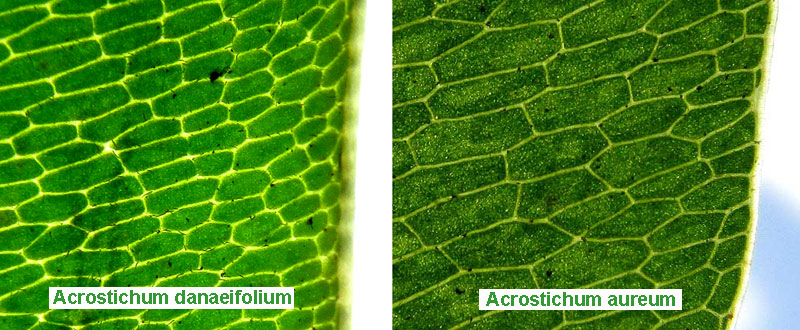Excerpts from Jim Conrad's
Naturalist Newsletter
from the November 13, 2006 Newsletter issued from Diego Nuñez's office above Restaurante "Isla Contoy," Río Lagartos, on the Yucatan Peninsula's northern coast (~N21.60°, ~W88.16°), Yucatán state, MÉXICO
GIANT LEATHER FERNS
South of town, waterlogged mangrove doesn't always give way just to thin-soiled, cactus-rich, desert scrub. In some places mangrove yields to grassy marshes -- clumps of grass rooted in mud, with soil between clumps either submerged beneath saltwater or soaked. Often, even in this important, officially recognized "Biosphere Reserve," cattle graze these marshes.
Sometimes Giant Leather Ferns, ACROSTICHUM DANAEFOLIUM, emerge from the soggy grassland. Taking in their effect, one might say "emerge like a Viking on a beach." In fern terms, these are huge, coarse-looking things giving the impression of having been rooted exactly where they are since dinosaur times. That's one of them below, with fronds soaring nearly nine feet (2.5 m) above the muck.

In the above picture the inset on the right shows a close-up of the fern's fertile pinnae. There you can see that this species produces its dusty, cinnamon-colored spores not in dainty clusters of spore-producing sporangia, like the North's little Woodsias and Shield Ferns, but rather they are randomly and abundantly spread across the entire lower surfaces of fertile pinnae.
Actually there are two species of Acrostichum fern found in places like ours, and I bet the other one, A. aureum, called Mangrove Fern, Golden Leather Fern, Swamp Fern and a host of other names, is found here, too. The "Flora of Quintana Roo" lists both species.
from the January 11, 2015 Newsletter issued from Río Lagartos, on the Yucatan Peninsula's northern coast (~N21.60°, ~W88.16°), Yucatán state, MÉXICO
FINE-TUNING THE LEATHER FERNS
Two giant leather fern species are listed for the Yucatan, Acrostichum danaefolium and Acrostichum aureum. I was pretty sure that our marsh-dwelling one was Acrostichum danaefolium, but would I recognize Acrostichum aureum if I came across it? The Flora of North America and other technical treatments all appear to be in general agreement about differences between the two species. On fronds of A. aureum, only the outermost segments, or pinnae, produce spores, while on A. danaeifolium the spore-producing pinnae occur throughout most of the frond. Aureum's pinnae don't overlap but danaeifolium's more or less do. And the cells, or "areoles," formed by the smallest veins at the edge of the pinnae are narrow in aureum but broad in danaeifolium.
After paying attention to hundreds of leather ferns in this area it's gradually dawned on me that we do have two distinct forms here, one thriving in full sunlight in grassy marshes, while the other lives in shadowy mangroves. However, the field marks outlined above haven't helped at all. The fronds of both species lose pinnae at their bottoms as they age, whether they're spore producing or not, so it's hard to say how much of a frond is spore producing. "More-or-less overlapping pinnae" appeared on both forms. Also,I've photographed areoles" at the edge of the pinnae of the two forms, and they're shown below:

I just don't see that much difference between them. The different sizes might be accounted for by the camera lens being at different distances from the pinnae. Even drawings of areoles in the Flora of North America don't clearly indicate the differences described between them. Maybe this is one of those times when experts generation after generation copy from one another with no one ever checking to see if what's written coincides with reality.
Still, something else said in the Flora of North America, where the situation is described in Florida where the two species coexist, fits perfectly what I find here. That is, "Acrosticum aureum is more frequently found in coastal shaded areas, in saline black-mangrove communities ... Acrostichum danaeifolium grows vigorously in full sun and is common and widely distributed in Florida."
That fits the two "forms" I've recognized here, so I continue to call the much more commonly found marsh-and-full-sun one Acrostichum danaeifolium, and the ones occurring in deep shade and often in standing water in the mangroves now I'll designate as Acrosticum aureum, often called the Golden Leather Fern.